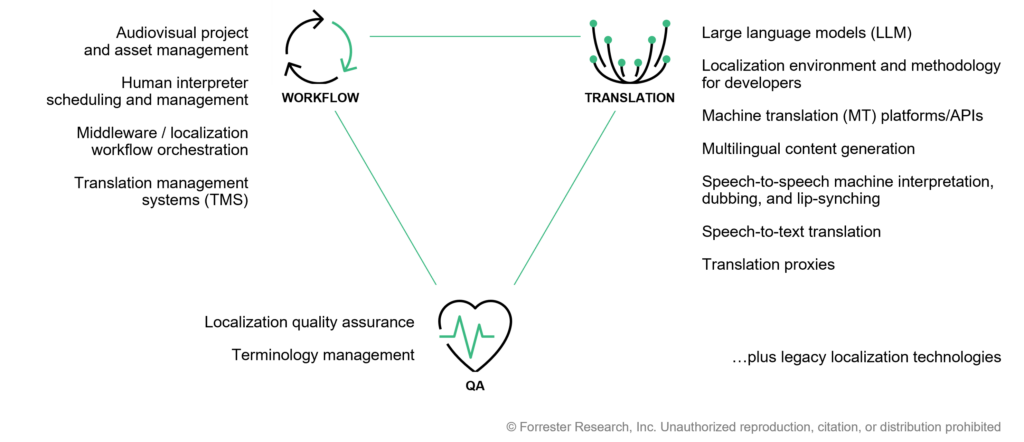Announcing The Forrester Tech Tide™: Enterprise Localization Technologies, Q1 2024
Do you sell into multilingual markets, nationally or internationally? Do you want to grow? If so, you should review your localization tech stack. We recently published The Forrester Tech Tide™: Enterprise Localization Technologies, Q1 2024 to help leaders in revenue operations, marketing, product, digital, content, and customer experience shape their firm’s investment approach.
A Rising Tide Overturns Traditional Localization Operations
A rising tide of new and improved localization technologies is about to wash over us. Smart enterprises will take this opportunity to up-level and expand global customer and employee engagement. Others will get swamped as individual functions purchase siloed technologies or continue treating localization as a “black box” handled by localization service providers (LSPs). When customers and employees use free tools that lack domain knowledge, business terminology, and brand voice, brand and compliance will suffer.
For decades, LSPs have been far more sophisticated than many of their enterprise customers, especially in B2B. LSPs use sophisticated technology at every step; enterprises do not. LSPs have unified processes and skilled localization leadership; enterprises are decentralized and tactical. LSPs maintain central resources such as translation memory and terminology management; enterprises have to balance consistency and cost savings against the flexibility to use multiple vendors. But in Forrester’s Marketing Survey, 2023, 59% of B2B marketing decision-makers indicated that they planned to increase spending on translation and localization software. We’re entering new waters.
Forrester Explored 14 Localization Technologies And Found a Fleet Of Automated Solutions
Forrester surveyed and interviewed technology decision-makers, suppliers, customers, and other subject matter experts in our search for the most important enterprise localization technologies. We were curious to discover the level of enterprise readiness and the breadth and depth of available options. What we found amounted to a sea change. While the localization technologies market comprises a wide range of vendor sizes and maturity, the common theme is automation. Workflows are fully automated, quality estimation and assurance are built in, and AI-driven translation is showing up everywhere.

Translation Management Systems And Middleware Are The Rudder
The reason why localization hasn’t taken off in many B2B organizations is that it’s slow, labor-intensive, and expensive. It’s complicated from the get-go because it’s always spread across marketing, product development, training, technical communications, HR, legal, and the partner ecosystem. Decentralization combined with manual processes at every step makes it impossible to scale.
Smart organizations implement translation management systems (TMSes) and middleware to steer the ship. TMSes, one of the most mature technologies that we examined, make central resources such as trained machine translation (MT), large language models (LLMs), terminology management, and project management available to all vendors. Middleware connects translation tools to enterprise applications to automate inputs and outputs.
Speech Technologies Turn A Rowboat Into A Powerboat
Localization used to center on written content, but Millennials and Gen Zers, who now form the majority of business buyers, prefer video. Work-from-home has injected live video into meetings, events, sales calls, marketing, support, and training. Within the next few years, autotranslated subtitles and captions, and autotranslated dubbing with AI-generated lip-synching, will become an expectation.
As we described in the Tech Tide report, enterprises can purchase localization technologies for speech-to-speech, speech-to-text, A/V project management, and human interpreter scheduling. Smart organizations will plan their speech localization strategy now.
Linguistic Quality Assurance Tools Filter Out Impurities
The central challenge of localization quality is that it’s hard to measure quality in something that you don’t understand. Unfortunately, the traditional approach of asking in-country employees to review translations is unscalable, inadequate, and contentious. They should be involved, yes, but they’re not machines.
Smart organizations will investigate linguistic quality assurance (LQA) tools, either in-house or via a tighter partnership with their LSP to gain visibility. LQA tools measure localization quality — style, tone, and terminology, as well as segment correspondence, grammar/spelling, and software testing. Automated corrections eliminate admin work, allowing human reviewers to focus on issues requiring their judgment. Reports provide quality metrics and trends along with feedback for reviewers and translators. Of all the tools I wish I’d had when I was leading localization, this is near the top.
Large Language Models, Multilingual Generative AI, And Machine Translation Are A Typhoon
It’s no hyperbole to say that the world is abuzz with excitement over AI. But while these technologies promise to make localization ubiquitous, they are not plug-and-play. To dig into the gap between promise and reality, we asked survey respondents to rate not only the potential or intrinsic business value of technologies but also the value that customers are getting now. LLMs received high scores for business value — and the highest negative rating for actual current value. Generative AI (genAI) and MT showed a similar pattern, as we would expect at their current stage of maturity and expansion. Like a typhoon, these technologies can move you fast and far but can also send you way off course.
Smart organizations will lose no time in experimenting with and investing in LLMs, multilingual genAI, and MT. In addition, they will assign skilled teams to clean up the training data sets and maintain close oversight of results.
This Fleet Needs A Commander
Deploying these technologies across an enterprise is no small task. The global organization of the future needs a skilled localization leader familiar with their business processes, enterprise architecture, content operations, LSPs, and audience preferences. In medium-to-large organizations, this should be a director or VP role. Backed by executive leadership and partnered with vendors and internal stakeholders, this leader can set a strong course and navigate around obstacles to reach the horizon.
Forrester clients who would like to discuss this Tech Tide and its application to their work can schedule a guidance session with me.
